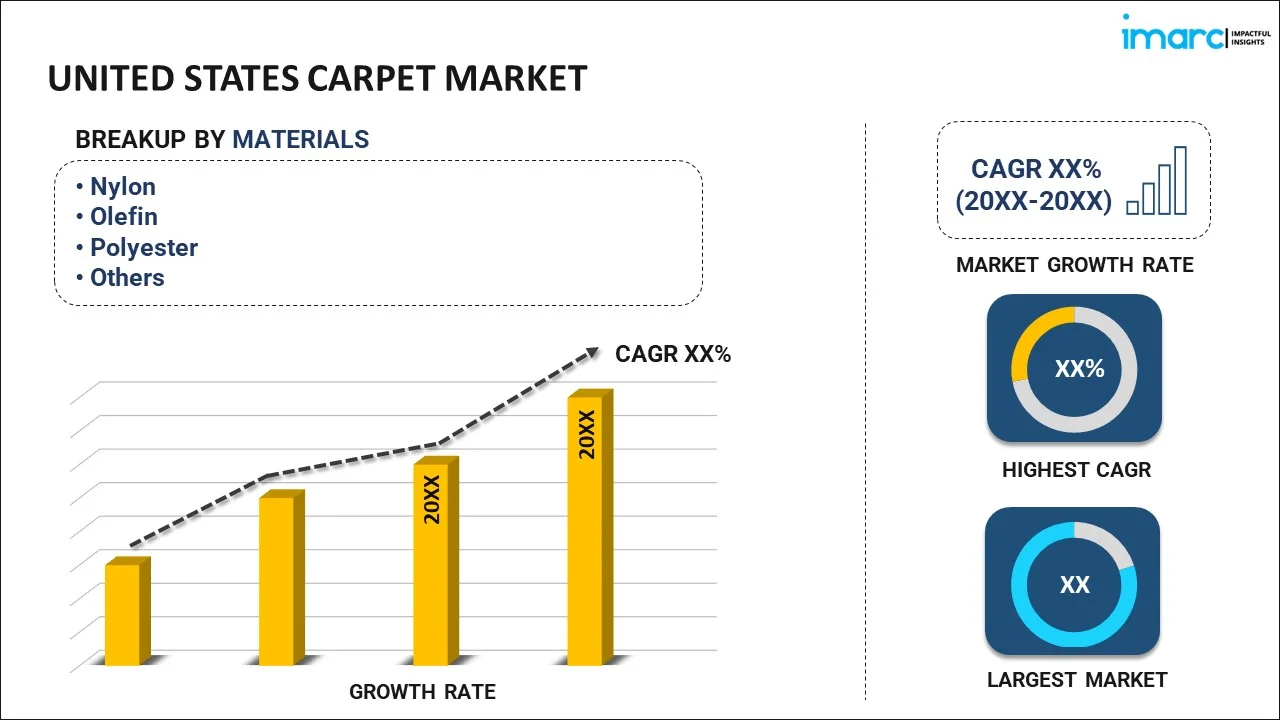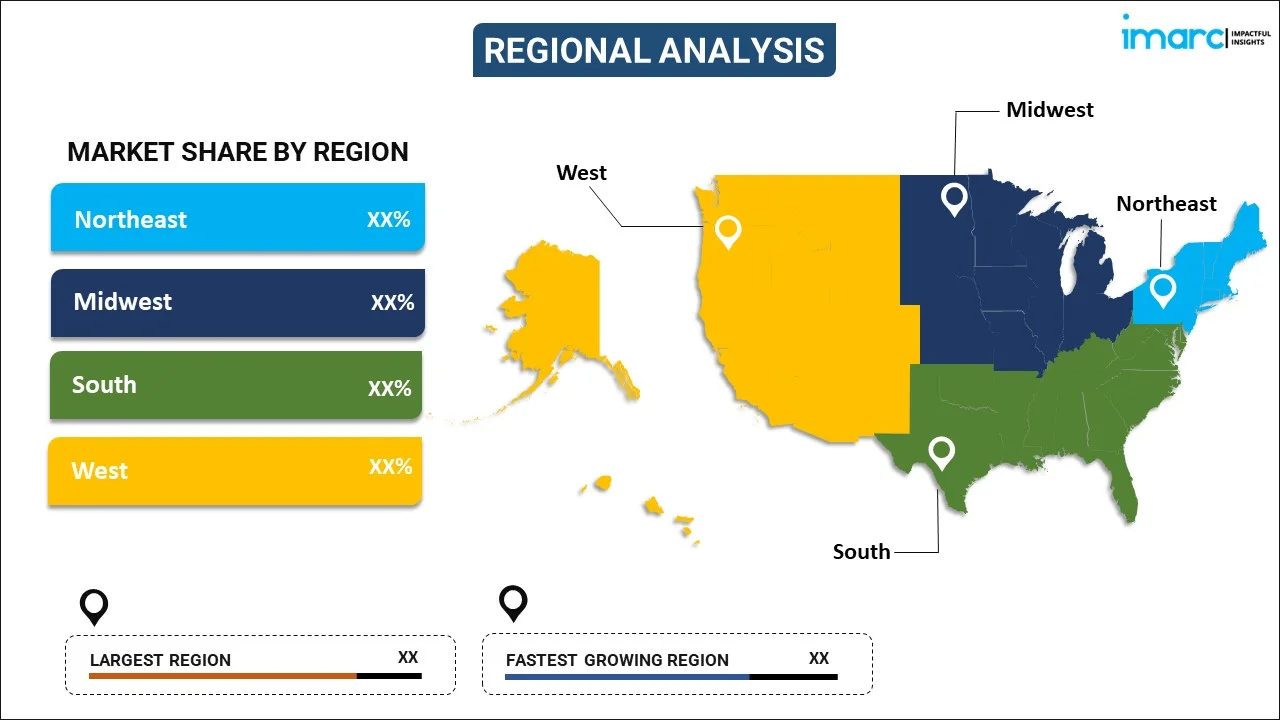
United States Carpet Market Report by Material (Nylon, Olefin, Polyester, and Others), Price Point (Economy, Luxury), Sales Channel (Supermarkets and Hypermarkets, Specialty Stores, Online Stores), End User (Residential, Commercial), and Region 2025-2033
Market Overview:
The United States carpet market size reached USD 16.0 Billion in 2024. Looking forward, IMARC Group expects the market to reach USD 21.1 Billion by 2033, exhibiting a growth rate (CAGR) of 3.1% during 2025-2033. The advent of environmentally friendly manufactured from natural fibers or recycled materials, innovations in the carpet processing method, such as stain-resistant technologies and the constant rise in new housing units represent some of the key factors driving the market.
|
Report Attribute
|
Key Statistics
|
|---|---|
|
Base Year
|
2024 |
|
Forecast Years
|
2025-2033
|
|
Historical Years
|
2019-2024
|
| Market Size in 2024 | USD 16.0 Billion |
| Market Forecast in 2033 | USD 21.1 Billion |
| Market Growth Rate (2025-2033) | 3.1% |
A carpet is a versatile textile floor covering traditionally comprised of two key components: an upper layer known as the pile and backing that provides structure. The pile, which gives the carpet its texture and appearance, was historically composed of wool. However, with advancements in textile technology, synthetic fibers such as polypropylene, nylon, or polyester have become increasingly popular. This is primarily due to their superior durability, stain resistance, and cost-effectiveness compared to natural alternatives. It is available in a variety of styles, ranging from wall-to-wall coverings to area rugs and runners. It is available in diverse colors and designs, offering consumers ample choices to match their aesthetic preferences and interior decor requirements. More than just a decorative element, it serves practical purposes too. It provides insulation against cold floors, reduces noise levels from walking, and adds a comforting, luxurious touch to spaces. The market has seen a rise in demand due to the development of carpets with improved texture, enhanced softness, and better stain resistance. Today, carpets form an integral part of home and commercial space decor with their blend of functional benefits and aesthetic appeal.
United States Carpet Market Trends:
A robust construction industry, particularly the residential sector, forms a significant part of the demand for carpets in the United States. The constant rise in new housing units, along with an increasing trend for home renovation and refurbishment, fuels the need for carpets, driving the market growth. Additionally, the inflating disposable income of consumers, coupled with a growing penchant for luxury home decor and comfort, has augmented the demand for high-end and premium carpets. Along with this, the advent of environmentally friendly, or 'green' carpets, manufactured from natural fibers or recycled materials, is gaining traction. These carpets, characterized by reduced emissions of volatile organic compounds (VOCs), are preferred by an increasing number of consumers due to a heightened awareness of sustainable practices and the impact of their choices on the environment. This shift towards sustainability is a significant trend driving the market. In addition, innovations in the carpet industry, such as stain-resistant technologies, improved durability, and enhanced design capabilities, are appealing to consumers, propelling the market forward. Manufacturers are increasingly focusing on research and development to create carpets that offer visual appeal and functional benefits such as durability, ease of maintenance, and longevity. Apart from this, the rise of online sales channels provides consumers with a wider variety of choices, convenient shopping experiences, and competitive prices, which are creating a positive market outlook. Some of the other factors driving the market include changing consumer preferences and the growing residential sector across the country.
United States Carpet Market Segmentation:
IMARC Group provides an analysis of the key trends in each segment of the United States carpet market report, along with forecasts at the country level for 2025-2033. Our report has categorized the market based on material, price point, sales channel, and end user.
Material Insights:

- Nylon
- Olefin
- Polyester
- Others
The report has provided a detailed breakup and analysis of the market based on the material. This includes nylon, olefin, polyester, and others.
Price Point Insights:
- Economy
- Luxury
A detailed breakup and analysis of the market based on the price point have also been provided in the report. This includes economy and luxury.
Sales Channel Insights:
- Supermarkets and Hypermarkets
- Specialty Stores
- Online Stores
The report has provided a detailed breakup and analysis of the market based on the sales channel. This includes supermarkets and hypermarkets, specialty stores, and online stores.
End User Insights:
- Residential
- Commercial
A detailed breakup and analysis of the market based on the end user have also been provided in the report. This includes residential and commercial.
Regional Insights:

- Northeast
- Midwest
- South
- West
The report has also provided a comprehensive analysis of all the major regional markets, which include Northeast, Midwest, South, and West.
Competitive Landscape:
The report has also provided a comprehensive analysis of the competitive landscape in the market. Competitive analysis such as market structure, key player positioning, top winning strategies, competitive dashboard, and company evaluation quadrant has been covered in the report. Also, detailed profiles of all major companies have been provided.
United States Carpet Market Report Coverage:
| Report Features | Details |
|---|---|
| Base Year of the Analysis | 2024 |
| Historical Period | 2019-2024 |
| Forecast Period | 2025-2033 |
| Units | Billion USD |
| Scope of the Report | Exploration of Historical and Forecast Trends, Industry Catalysts and Challenges, Segment-Wise Historical and Predictive Market Assessment:
|
| Materials Covered | Nylon, Olefin, Polyester, Others |
| Price Points Covered | Economy, Luxury |
| Sales Channels Covered | Supermarkets and Hypermarkets, Specialty Stores, Online Stores |
| End Users Covered | Residential, Commercial |
| Regions Covered | Northeast, Midwest, South, West |
| Customization Scope | 10% Free Customization |
| Post-Sale Analyst Support | 10-12 Weeks |
| Delivery Format | PDF and Excel through Email (We can also provide the editable version of the report in PPT/Word format on special request) |
Key Questions Answered in This Report:
- How has the United States carpet market performed so far and how will it perform in the coming years?
- What has been the impact of COVID-19 on the United States carpet market?
- What is the breakup of the United States carpet market on the basis of material?
- What is the breakup of the United States carpet market on the basis of price point?
- What is the breakup of the United States carpet market on the basis of sales channel?
- What is the breakup of the United States carpet market on the basis of end user?
- What are the various stages in the value chain of the United States carpet market?
- What are the key driving factors and challenges in the United States carpet market?
- What is the structure of the United States carpet market and who are the key players?
- What is the degree of competition in the United States carpet market?
Key Benefits for Stakeholders:
- IMARC’s report offers a comprehensive quantitative analysis of various market segments, historical and current market trends, market forecasts, and dynamics of the United States carpet market from 2019-2033.
- The research study provides the latest information on the market drivers, challenges, and opportunities in the United States carpet market.
- Porter's five forces analysis assist stakeholders in assessing the impact of new entrants, competitive rivalry, supplier power, buyer power, and the threat of substitution. It helps stakeholders to analyze the level of competition within the United States carpet industry and its attractiveness.
- Competitive landscape allows stakeholders to understand their competitive environment and provides an insight into the current positions of key players in the market.
Need more help?
- Speak to our experienced analysts for insights on the current market scenarios.
- Include additional segments and countries to customize the report as per your requirement.
- Gain an unparalleled competitive advantage in your domain by understanding how to utilize the report and positively impacting your operations and revenue.
- For further assistance, please connect with our analysts.
 Inquire Before Buying
Inquire Before Buying
 Speak to an Analyst
Speak to an Analyst
 Request Brochure
Request Brochure
 Request Customization
Request Customization




.webp)




.webp)












